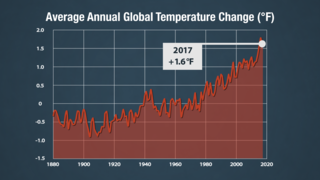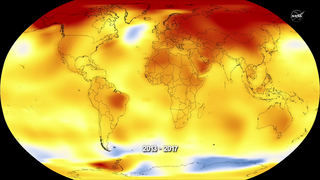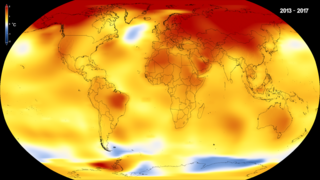Earth
ID: 12847

2017 was the second hottest year on Earth since global temperature estimates first became possible in 1880. Although 2016 still holds the record for the warmest year, 2017 came in a close second, with average temperatures 1.6 degrees Fahrenheit (0.90 degrees Celsius) higher than the average of the mid-20th century. 2017’s temperature record is especially noteworthy, because we didn’t have an El Niño this year, the periodic warming of the tropical Pacific Ocean waters, which affect wind and weather patterns, and usually results in warmer temperatures globally. NASA scientists analyze temperature data from 6,300 weather stations and ship- and buoy-based observations around the world on a monthly and yearly basis. Researchers at the National Oceanic and Atmospheric Administration (NOAA) do a similar but independent analysis, and their 2017 analysis tracked closely with NASA's. Since the global temperature is an average for the whole planet, different places on Earth experienced different amounts of warming, with the strongest warming trends seen in the Arctic regions. Increasing global temperatures are the result of human activity, specifically the release of greenhouse gases like carbon dioxide and methane, which trap heat inside the atmosphere, raising temperatures around the globe. Watch the videos to learn more.

Warm World of 2017


Source Material
For More Information
Story Credits
Lead Visualizers/Animators:
Kel Elkins (USRA)
Lori Perkins (NASA/GSFC)
Lead Producers:
Kathryn Mersmann (USRA)
Matthew R. Radcliff (USRA)
Lead Scientist:
Gavin A. Schmidt (NASA/GSFC GISS)
Lead Writer:
Kate Ramsayer (Telophase)
Kel Elkins (USRA)
Lori Perkins (NASA/GSFC)
Lead Producers:
Kathryn Mersmann (USRA)
Matthew R. Radcliff (USRA)
Lead Scientist:
Gavin A. Schmidt (NASA/GSFC GISS)
Lead Writer:
Kate Ramsayer (Telophase)
Please give credit for this item to:
NASA's Scientific Visualization Studio
NASA's Scientific Visualization Studio
Short URL to share this page:
https://svs.gsfc.nasa.gov/12847
Keywords:
SVS >> HDTV
SVS >> App
NASA Science >> Earth
https://svs.gsfc.nasa.gov/12847
Keywords:
SVS >> HDTV
SVS >> App
NASA Science >> Earth










